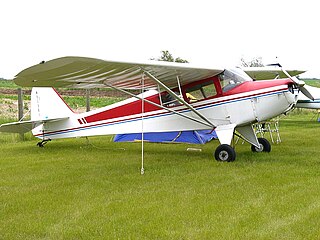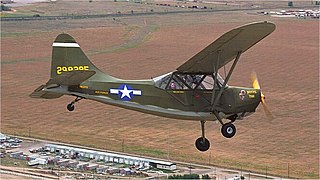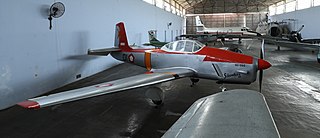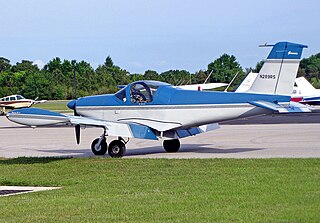
The Piper J-3 Cub is an American light aircraft that was built between 1938 and 1947 by Piper Aircraft. The aircraft has a simple, lightweight design which gives it good low-speed handling properties and short-field performance. The Cub is Piper Aircraft's most-produced model, with nearly 20,000 built in the United States. Its simplicity, affordability and popularity invokes comparisons to the Ford Model T automobile.

The Cessna 120,140, and 140A, are single-engine, two-seat, conventional landing gear (tailwheel), light general aviation aircraft that were first produced in 1946, immediately following the end of World War II. Production ended in 1951, and was succeeded in 1959 by the Cessna 150, a similar two-seat trainer which introduced tricycle gear. Combined production of the 120, 140, and 140A was 7,664 units in five years.

The Taylorcraft B is an American light, single-engine, high-wing general aviation monoplane, with two seats in side-by-side configuration, that was built by the Taylorcraft Aviation Corporation of Alliance, Ohio.

The Cessna 310 is an American four-to-six-seat, low-wing, twin-engine monoplane produced by Cessna between 1954 and 1980. It was the second twin-engine aircraft that Cessna put into production; the first was the Cessna T-50. It was used by the U.S. military as the L-27, after 1962, U-3. Over six thousand Cessna 310 and 320 aircraft were produced between 1954 and 1980.

The RyanNavion is a single-engine, unpressurized, retractable gear, four-seat aircraft originally designed and built by North American Aviation in the 1940s. It was later built by Ryan Aeronautical Company and the Tubular Steel Corporation (TUSCO).

The Aeronca L-3 group of observation and liaison aircraft were used by the United States Army Air Corps in World War II. The L-3 series were adapted from Aeronca's pre-war Tandem Trainer and Chief models.

Indonesian Aerospace (IAe), is an Indonesian aerospace company involved in aircraft design and the development and manufacture of civilian and military regional commuter aircraft, and a subsidiary of state-owned electronics manufacturer Len Industri. The company was formerly known as PT Industri Pesawat Terbang Nusantara (Persero). It was expanded from a research and industrial facility under the auspices of the Indonesian Air Force, namely Lembaga Industri Penerbangan Nurtanio (LIPNUR) or Nurtanio Aviation Industry Institute.

The Luscombe 8 is a series of high-wing, side-by-side-seating monoplanes with conventional landing gear, designed in 1937 and built by Luscombe Aircraft.

The Stinson L-5 Sentinel is a World War II-era liaison aircraft used by the United States Army Air Forces (USAAF), U.S. Army Ground Forces, U.S. Marine Corps and the British Royal Air Force. It was produced by the Stinson Division of the Vultee Aircraft Company. Along with the Stinson L-1 Vigilant, the L-5 was the only other USAAF liaison aircraft that was exclusively built for military use and had no civilian counterpart.

The Interstate Cadet is an American two-seat tandem, high wing, single-engine monoplane light aircraft. Around 320 of these aircraft were produced between the years 1941 and 1942 by the Interstate Aircraft and Engineering Corporation based in El Segundo, California. The construction techniques employed were a welded steel tube fuselage, wood (spruce) wing structure with metal ribs, and fabric covering, all of which were fairly standard in the 1940s.

The Aeronca Model 7 Champion, commonly known as the "Champ", or "Airknocker", is a single-engine light airplane with a high wing, generally configured with fixed conventional landing gear and tandem seating for two occupants.

The LIPNUR Sikumbang was a low-wing monoplane of mixed construction built in Indonesia in 1954 as a COIN and anti-guerrilla-warfare aircraft. Of conventional configuration, it had fixed tricycle undercarriage and seated the pilot under a bubble canopy. A single example was built under the designation NU-200 in 1954, and another as the NU-225 in 1957. The latter machine was grounded in 1967.

The LIPNUR Kunang was a single-seat sports aircraft built in Indonesia that first flew in 1958 in the hope that it would inspire interest in aviation amongst Indonesian youth. The only example that was built was subsequently grounded. It was a single-seat monoplane of conventional layout with fixed tailwheel undercarriage.
LIPNUR developed and manufactured the Super Kunang - also known as the Super Kunang 35 - in the 1960s. Powered by a Volkswagen air-cooled engine and seating only one person, it was used as a light sports plane.
The Piper PA-6 Sky Sedan was a 1940s American four-seat light aircraft designed and built in prototype form by Piper Aircraft at its Lock Haven, Pennsylvania, factory.

The Pazmany PL-1 Laminar and Pazmany PL-2 are American two-seat trainer and personal light aircraft designed by Ladislao Pazmany to be marketed as a homebuilt aircraft by his company Pazmany Aircraft Corporation. The aircraft was built under license in Taiwan as the AIDC PL-1B Cheinshou. It was later followed by an improved version the PL-2. The SLAF Aircraft Engineering Wing developed a modified variant of the PL-2 in 1977, which was never used operationally.

The SIPA S.90 was a French-built two-seat light touring and training aircraft of the 1940s and 1950s.
The Dudek V-1 Sportplane is a low wing, conventional landing gear, homebuilt aircraft developed from the Piper J-2 Cub.

The Aeronca K series, Aeronca Chief, Aeronca Super Chief, Aeronca Tandem, Aeronca Scout, Aeronca Sea Scout, Aeronca Champion and Aeronca Defender were a family of American high-winged light touring aircraft, designed and built starting in the late 1930s by Aeronca Aircraft.
















